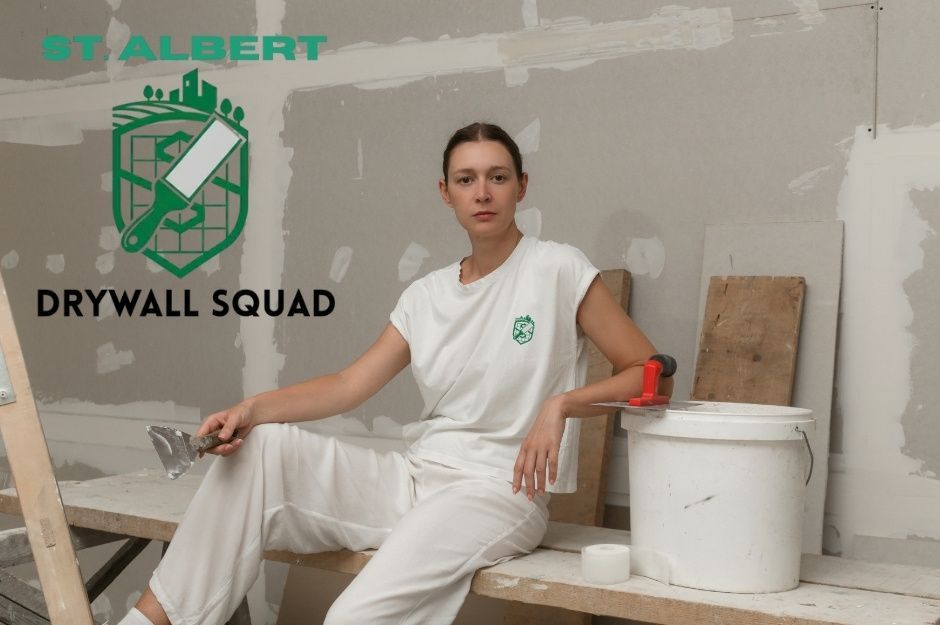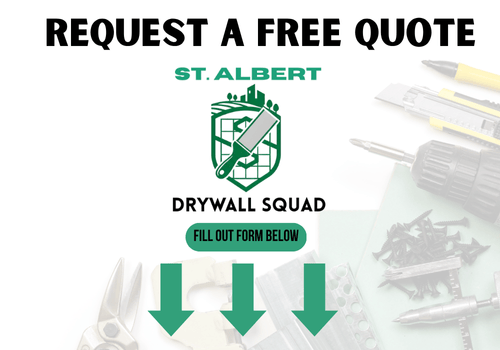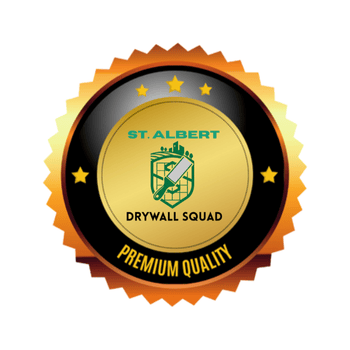Devon Drywall Repair
Expert Drywall Repair Company in Devon, Alberta
St. Albert Drywall Squad (CP)

Drywall damage is a common issue in Devon, Alberta homes, whether from settling, moisture, accidental impacts, or general wear and tear. Professional drywall repair contractors at St. Albert Drywall Squad in Devon offer comprehensive services including patching holes, fixing cracks, removing popcorn ceilings, repairing water damage, and handling complete installations and finishing work.

St. Albert Drywall Squad (CP)

When you need drywall repairs, choosing the right contractor makes the difference between a seamless fix and a noticeable patch job. The local Devon contractors understand the unique challenges of Alberta's climate and building standards, particularly important in this town of 6,545 residents located 26 km southwest of Edmonton along the North Saskatchewan River.
Devon's warm-summer humid continental climate (Köppen: Dfb) with temperatures ranging from -46°C to 35.5°C creates unique stresses on drywall, including expansion and contraction cycles that can cause cracks and settling issues.
The scope of drywall services extends beyond basic patching to include full installations for renovations, expert finishing techniques for smooth walls, and specialized repairs for water damage or structural issues. Understanding what services are available and how to select qualified contractors will help you make informed decisions for your home improvement projects.
Choosing Drywall Repair Contractors in Devon, Alberta
Finding the right drywall repair contractor requires evaluating their professional credentials, understanding their local coverage area, comparing pricing structures, and recognizing the value that experienced professionals bring to your project.
What to Look for in a Professional Drywall Repair Service
Professional drywall repair services demonstrate their expertise through proper licensing and insurance coverage. You should verify that contractors carry liability insurance and workers' compensation to protect your property and their employees.
Look for contractors who specialize in the specific repair you need. Some focus on water damage restoration, while others excel at patching holes or removing popcorn ceilings.
Key qualifications include:
- Valid business licenses
- Comprehensive insurance coverage
- References from recent projects
- Portfolio of completed work
- Experience with Devon's specific building codes under Leduc County jurisdiction
Reviews and ratings on platforms like Yelp, Better Business Bureau, and Houzz provide insight into service quality. Check multiple sources to get a complete picture of the contractor's reputation.
Professional drywall repair contractors use quality materials and proper techniques. They should explain their repair process and provide detailed estimates that break down materials and labor costs.
Local Expertise and Service Area Coverage
Devon-based contractors understand local building codes and climate conditions that affect drywall installations. Since Devon was incorporated as a town in 1950 and built by Imperial Oil as a planned community, many homes date to the mid-20th century and may have older drywall systems requiring specialized knowledge. They know which materials perform best in Alberta's temperature fluctuations and humidity levels.
Local contractors typically offer faster response times for urgent repairs. They can assess damage quickly and begin work without extensive travel delays.
Advantages of local contractors:
- Familiarity with area building requirements
- Established relationships with local suppliers
- Quick response for emergency repairs
- Understanding of regional construction practices
- Knowledge of Devon's historic oil industry infrastructure and how it affects residential construction
- Experience with properties in the Edmonton Metropolitan Region (Census Division 11)
Many contractors serving Devon also cover surrounding areas like Edmonton (26 km northeast), Leduc, Beaumont, and Parkland County. Contractors familiar with Highway 19 and Highway 60 access routes can provide efficient service scheduling. This broader service area often indicates established businesses with reliable transportation and scheduling systems.
Innovation Drywall and other Devon-area contractors offer specialized knowledge of residential and commercial properties common in the region.
Comparing Drywall Repair Costs
Drywall repair cost varies based on damage extent, materials required, and contractor expertise. Small holes typically cost $75-150 per repair, while larger sections may range from $200-500.
Water damage repairs involve additional considerations like moisture testing and mold prevention, particularly important in Devon where average annual precipitation reaches 508mm and basement flooding from the nearby North Saskatchewan River can occur. These projects generally cost 25-50% more than standard patching work.
| Repair Type | Typical Cost Range |
|---|---|
| Small holes (nail/screw) | $75-$125 |
| Medium holes (fist-sized) | $125-$250 |
| Large sections | $200-$500 |
| Ceiling repairs | $150-$400 |
| Water damage | $300-$800+ |
| Climate-related crack repairs (settling) | $150-$350 |
Request detailed quotes from at least three contractors. Compare material quality, timeline, and warranty coverage alongside pricing.
The lowest bid isn't always the best value. Consider the contractor's reputation, materials used, and project timeline when evaluating quotes.
Benefits of Hiring Experienced Contractors
Experienced drywall repair contractors identify underlying issues that inexperienced workers might miss, including foundation settling common in Devon homes built on Devonian formation geology. They spot structural problems, moisture issues, or electrical concerns before beginning repairs.
Skilled professionals complete repairs faster and with better results. Their expertise reduces the risk of callbacks and ensures repairs blend seamlessly with existing walls.
Professional advantages include:
- Advanced diagnostic skills
- Access to specialized tools
- Knowledge of best practices
- Warranty on completed work
- Understanding of how Devon's 8.8 annual nights below -30°C affect drywall integrity
Experienced contractors handle unexpected complications efficiently. When repairs reveal additional damage or structural issues, they can adapt their approach without significant delays.
Professional drywall repair services use primer, paint matching, and texture application techniques that make repairs virtually invisible. This expertise is particularly valuable for challenging repairs in prominent locations.
Many established contractors offer guarantees on their work, providing peace of mind and protection for your investment.
Comprehensive Drywall Repair Services
Professional drywall contractors in Devon, Alberta offer specialized repair solutions for common wall and ceiling issues. These services range from simple patch jobs to complex water damage restoration and textured ceiling removal.
Patch and Small Hole Repairs
Small holes and dents in your drywall require specific repair techniques depending on their size and location. Contractors use mesh patches for holes smaller than three inches and backing boards for larger openings.
The repair process involves cutting the damaged area into a clean square or circle. A reinforcement panel or mesh backing gets installed behind the opening to provide structural support.
Drywall compound fills the void in multiple thin layers. Each layer must dry completely before the next application to prevent cracking or uneven surfaces.
Common patch repair sizes:
- Nail holes: Spackling compound only
- Small dents: Single coat of compound
- Medium holes (1-3 inches): Mesh patch required
- Large holes (3+ inches): Backing board installation
Final sanding creates a smooth surface that matches the surrounding wall texture before priming and painting.
Repairing Cracks and Damage
Drywall cracks occur from house settling, temperature changes, or structural movement—particularly common in Devon where 58.4% of days reach freezing temperatures or below, causing significant expansion-contraction cycles. Different crack types require specific repair approaches for lasting results.
Hairline cracks need mesh tape and joint compound applied in thin coats. Wider cracks may indicate structural issues that require addressing the underlying cause first.
Corner cracks often result from improper installation or building settlement. These repairs involve removing loose material and applying new corner bead if necessary.
Contractors sand the repaired area smooth and apply primer before matching your existing wall texture. This ensures the repair blends seamlessly with surrounding surfaces.
Popcorn Ceiling Removal and Ceiling Repair
Popcorn ceiling removal involves scraping textured material from ceiling surfaces, a common service in Devon where many original homes from the 1950s oil boom era feature this dated texture. This process requires plastic sheeting to protect floors and furniture from debris.
Contractors test older ceilings for asbestos before starting removal work. Professional testing ensures safe handling if hazardous materials are present.
The removal process includes wetting the texture to reduce dust and carefully scraping with specialized tools. Damaged drywall underneath gets patched and smoothed during this phase.
After removal, contractors apply new joint compound and sand the surface smooth. You can then choose a new ceiling texture or leave it with a smooth finish.
Addressing Water Damage in Drywall
Water-damaged drywall requires immediate attention to prevent mold growth and structural deterioration, especially important in Devon where the town sits at 709m elevation along the North Saskatchewan River with average annual precipitation of 508mm. Contractors assess the extent of damage before determining repair or replacement needs.
Moisture meters help identify hidden water penetration beyond visible staining. Areas with extensive saturation typically need complete drywall replacement rather than repair.
Water damage assessment factors:
- Moisture content levels
- Duration of water exposure
- Presence of mold growth
- Structural integrity of affected areas
- Proximity to the North Saskatchewan River and flood risk zones
Contractors remove damaged sections and treat the area with antimicrobial solutions. New drywall installation includes proper vapor barriers to prevent future moisture problems.
The repair area gets sealed with stain-blocking primer before final painting to prevent water stains from bleeding through your new finish.
Drywall Installation and Finishing Solutions
Professional drywall installation involves precise hanging, taping, and finishing techniques to create smooth, paint-ready surfaces. Surface preparation and priming ensure optimal adhesion for your chosen paint or wallpaper application.
Drywall Installation Process
Contractors begin by measuring wall dimensions and cutting drywall panels to fit your specific room layout. Each panel gets secured to wall framing using drywall screws spaced 12 inches apart along studs.
Installation Steps:
- Measure and cut panels to size
- Position panels against framing
- Secure with appropriate fasteners
- Check alignment and levelness
- Account for Devon's temperature extremes (-46°C to 35.5°C) by allowing proper expansion gaps
Professional installers ensure proper spacing between panels for expansion. They cut precise openings for electrical outlets, switches, and fixtures during installation.
The hanging process requires attention to stud placement and proper fastener depth. Screws must sit slightly below the surface without breaking the paper backing.
Drywall Finishing Techniques
Finishing transforms raw drywall seams into smooth, continuous surfaces through taping and joint compound application. This multi-step process requires three separate coats for professional results.
Three-Coat System:
- First coat: Embed tape in joint compound
- Second coat: Apply wider compound layer
- Third coat: Feather edges for seamless blend
Each coat must dry completely before sanding and applying the next layer. Contractors use different knife widths for each coat, progressing from 6-inch to 12-inch blades.
Corner beads protect outside corners from damage while creating crisp, straight edges. Metal or plastic beads get installed before compound application.
Sanding between coats removes imperfections and ridges. Fine-grit sandpaper prevents gouging the compound surface.
Surface Preparation and Priming
Proper surface preparation ensures your paint adheres correctly and provides uniform coverage across repaired areas. Contractors remove all dust particles and debris before primer application.
Preparation Checklist:
- Remove sanding dust with tack cloth
- Fill any remaining small holes
- Check surface smoothness
- Apply appropriate primer type
- Consider Devon's low humidity levels (average 96 frost-free days) when selecting quick-dry primers
Primer selection depends on your final finish choice and existing wall conditions. High-quality primers seal porous joint compound and create consistent surface texture.
New drywall requires complete primer coverage since joint compound and paper backing absorb paint differently. Spot-priming repair areas prevents color variations in your final paint job.
Painting and Wallpaper Services
Many drywall contractors offer painting services as part of complete wall finishing packages. This ensures seamless coordination between surface preparation and final coating application.
Paint Application Process:
- Apply primer to all surfaces
- Use quality brushes and rollers
- Apply paint in thin, even coats
- Allow proper drying time between coats
Wallpaper installation requires perfectly smooth surfaces that professional drywall finishing provides. Contractors ensure walls meet wallpaper manufacturer specifications for adhesion.
Paint selection affects durability and appearance of your finished walls. Semi-gloss paints work well in high-moisture areas, while flat paints hide minor surface imperfections.
Professional painters use proper techniques to avoid brush marks and roller stipple patterns. They maintain wet edges during application for uniform coverage.
Tools, Materials, and Best Practices
Professional drywall work requires specific power tools, quality materials, and proper safety protocols. The right equipment and techniques ensure clean results and efficient project completion.
Essential Power Tools for Drywall Work
Drills and Drivers are fundamental for drywall installation. A cordless drill with variable speed control handles drywall screws without overdriving. Drywall screw guns provide better control for large projects.
Cutting Tools streamline material preparation. Reciprocating saws cut openings for outlets and fixtures. Oscillating multi-tools make precise cuts in tight spaces.
Sanders create smooth finishes. Pole sanders reach high areas and corners efficiently. Electric sanders with dust collection reduce cleanup time and improve air quality.
Compressors and Spray Equipment speed up texture application. Small compressors power pneumatic tools and spray textures evenly. Hopper guns apply popcorn texture and other finishes.
Additional power tools include:
- Rotary hammers for anchor installation
- Wet/dry vacuums for dust control
- Work lights for proper visibility
- Portable heaters for winter work in Devon's harsh climate (average 8.8 nights below -30°C annually)
Recommended Materials and Compounds
Joint Compounds vary by application type. All-purpose compound works for taping and finishing. Lightweight compounds sand easier and dry faster. Setting compounds provide strength for repairs.
Tape Selection affects joint quality:
- Paper tape creates strong, crack-resistant joints
- Mesh tape speeds application but requires more compound
- Corner beads protect outside corners from damage
- Flexible tape for Devon homes experiencing foundation movement from temperature cycling
Fasteners must match the application. Coarse-thread screws work for wood framing. Fine-thread screws attach to metal studs. Length depends on drywall thickness.
Primers and Paints seal surfaces properly. PVA primers prevent compounds from showing through paint. High-quality paints provide better coverage and durability.
Safety and Clean-Up Procedures
Personal Protection prevents health issues. Dust masks filter airborne particles during sanding. Safety glasses protect eyes from debris. Work gloves prevent cuts and improve grip.
Workspace Preparation maintains cleanliness. Plastic sheeting protects floors and furniture. Drop cloths catch falling debris. Proper ventilation removes dust and fumes.
Tool Maintenance extends equipment life. Clean compound from tools before it hardens. Store blades and bits properly to prevent damage. Regular maintenance keeps power tools running efficiently.
Dust Control improves working conditions. Wet sanding reduces airborne particles. Vacuum attachments on sanders capture dust at the source. Daily cleanup prevents buildup throughout the project.
For Devon contractors servicing the T9G postal area, proper disposal of construction debris follows Leduc County regulations and environmental standards established for the Edmonton Metropolitan Region.